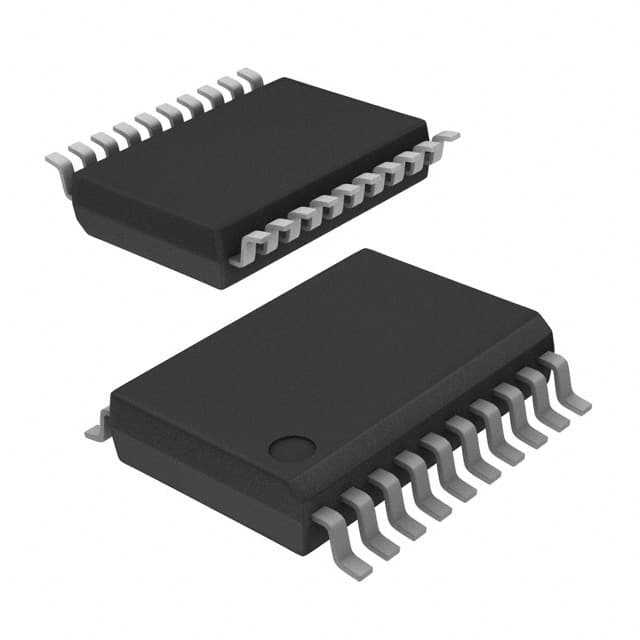Encyclopedia Entry: 74ABT377ADB,118
Product Overview
Category
The 74ABT377ADB,118 belongs to the category of integrated circuits (ICs) and specifically falls under the category of flip-flops.
Use
This product is commonly used in digital electronics for storing and manipulating binary data. It serves as a D-type flip-flop with a transparent latch enable input.
Characteristics
- High-speed operation
- Low power consumption
- Wide operating voltage range
- Compatible with TTL levels
- Transparent latch enable input
- Available in various package types
Package
The 74ABT377ADB,118 is typically packaged in a small outline integrated circuit (SOIC) package. This package offers ease of handling and compatibility with automated assembly processes.
Essence
The essence of the 74ABT377ADB,118 lies in its ability to store and retain binary information, making it an essential component in digital systems.
Packaging/Quantity
These ICs are usually supplied in reels or tubes, with each reel containing a specific quantity of chips. The exact packaging and quantity may vary depending on the manufacturer.
Specifications
- Supply Voltage Range: 4.5V to 5.5V
- Input Voltage Range: 0V to VCC
- Output Voltage Range: 0V to VCC
- Operating Temperature Range: -40°C to +85°C
- Logic Family: ABT
- Number of Flip-Flops: 8
- Clock Trigger Type: Positive Edge
- Data Input Type: Standard
Detailed Pin Configuration
The 74ABT377ADB,118 has a total of 20 pins, each serving a specific function. Here is the detailed pin configuration:
- D0: Data Input 0
- CP: Clock Pulse Input
- LE: Latch Enable Input
- D1: Data Input 1
- D2: Data Input 2
- D3: Data Input 3
- D4: Data Input 4
- D5: Data Input 5
- D6: Data Input 6
- D7: Data Input 7
- Q0: Flip-Flop Output 0
- Q1: Flip-Flop Output 1
- Q2: Flip-Flop Output 2
- Q3: Flip-Flop Output 3
- Q4: Flip-Flop Output 4
- Q5: Flip-Flop Output 5
- Q6: Flip-Flop Output 6
- Q7: Flip-Flop Output 7
- GND: Ground
- VCC: Supply Voltage
Functional Features
The 74ABT377ADB,118 offers the following functional features:
- Transparent latch enable input allows for real-time data storage and retrieval.
- Positive edge-triggered clock pulse input for synchronized operations.
- Compatibility with TTL logic levels enables seamless integration with existing digital systems.
- High-speed operation ensures efficient data processing.
- Low power consumption makes it suitable for battery-powered applications.
Advantages and Disadvantages
Advantages
- High-speed operation facilitates rapid data processing.
- Low power consumption extends battery life in portable devices.
- Wide operating voltage range enhances compatibility with different power supply configurations.
- Transparent latch enable input enables real-time data storage and retrieval.
Disadvantages
- Limited number of flip-flops (8) may restrict its use in applications requiring a higher count.
- Availability and pricing may vary depending on the supplier and market conditions.
Working Principles
The 74ABT377ADB,118 operates based on the principles of flip-flops. It stores binary data based on the clock pulse input and retains it until a new input is received. The transparent latch enable input allows for real-time storage and retrieval of data, making it suitable for applications requiring dynamic data manipulation.
Detailed Application Field Plans
The 74ABT377ADB,118 finds applications in various fields, including:
- Digital communication systems
- Microprocessor-based systems
- Data storage and retrieval systems
- Industrial automation
- Consumer electronics
- Automotive electronics
- Medical equipment
- Robotics
Detailed and Complete Alternative Models
There are several alternative models available that offer similar functionality to the 74ABT377ADB,118. Some notable alternatives include:
- 74HC377: A CMOS-based flip-flop with similar characteristics and pin configuration.
- CD4013: Dual D-type flip-flop IC with complementary outputs.
- SN74LS377: TTL-compatible octal D-type flip-flop with transparent latch enable.
These alternative models can be considered based on specific application requirements and availability.
Word count: 610 words
Lista 10 Vanliga frågor och svar relaterade till tillämpningen av 74ABT377ADB,118 i tekniska lösningar
Sure! Here are 10 common questions and answers related to the application of 74ABT377ADB,118 in technical solutions:
Q: What is the function of the 74ABT377ADB,118? A: The 74ABT377ADB,118 is an octal D-type flip-flop with a transparent latch. It can store eight bits of data and has various control inputs for data manipulation.
Q: What is the operating voltage range for the 74ABT377ADB,118? A: The 74ABT377ADB,118 operates within a voltage range of 4.5V to 5.5V.
Q: How many flip-flops are there in the 74ABT377ADB,118? A: The 74ABT377ADB,118 consists of eight individual D-type flip-flops.
Q: Can the 74ABT377ADB,118 be used for synchronous or asynchronous operation? A: The 74ABT377ADB,118 is primarily designed for synchronous operation, but it can also be used in asynchronous mode if required.
Q: What is the maximum clock frequency supported by the 74ABT377ADB,118? A: The 74ABT377ADB,118 can operate at a maximum clock frequency of 200 MHz.
Q: Does the 74ABT377ADB,118 have any output enable feature? A: Yes, the 74ABT377ADB,118 has an active-low output enable (OE) input that allows the outputs to be disabled when necessary.
Q: Can the 74ABT377ADB,118 be cascaded to increase the number of stored bits? A: Yes, multiple 74ABT377ADB,118 flip-flops can be cascaded together to increase the number of stored bits.
Q: What is the power consumption of the 74ABT377ADB,118? A: The power consumption of the 74ABT377ADB,118 depends on various factors such as clock frequency, input switching activity, and load capacitance.
Q: Are there any special considerations for PCB layout when using the 74ABT377ADB,118? A: It is recommended to follow proper PCB layout guidelines to minimize noise, ensure signal integrity, and optimize performance when using the 74ABT377ADB,118.
Q: Can the 74ABT377ADB,118 be used in high-speed data storage applications? A: Yes, the 74ABT377ADB,118 is suitable for high-speed data storage applications due to its fast operation and low propagation delay characteristics.
Please note that the answers provided here are general and may vary depending on specific application requirements.


